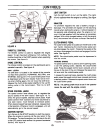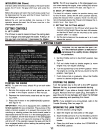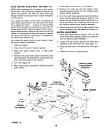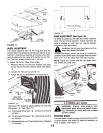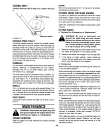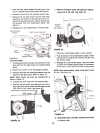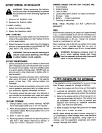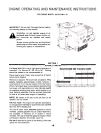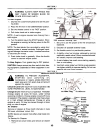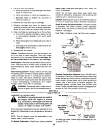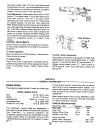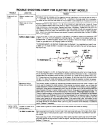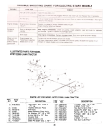
BATTERY REMOVAL OR INSTALlATION
A WARNING: When removing the battery,
follow this order of disassembly to prevent
the screwdriver from shorting against the
frame.
COMMON CAUSES FOR BATTERY FAILURE ARE:
1. Overcharging
2. Undercharging
3. Lack of water
4. Loose holds downs and/or corroded connections
5. Excessiv~ loads
6. Battery :':trolyte substitutes
7. Freezing of electrolyte
NOTE: THESE FAILURES DO NOT CONSTITUTE
WARRANTY.
1. Remove the Negative cable.
2. Remove the Positive cable.
To install a battery:
1. Attach the Positive cable.
2. Attach the Negative cable.
TIRES
Recommended operating tire pressure is approximately
12 p.s.i. (check sidewall of tire for tire manufacturer's
recommended pressure). Maximum tire pressure under
any circumstances is 30 p.s.i. Equat tire pressure
should be maintained on all tires.
When installing a tire to the rim, be certain rim is clean
and free of rust. Lubricate both the tire and rim
generously. Never inflate to over 30 p.s.i. to seat beads.
JUMP STARTING
1. Attach the first jumper cable from the Positive ter-
minal of the good battery to the Positive terminal
of the dead battery.
2. Attach the second jumper cable from the Negative
terminal of the good battery to the FRAME OF THE
UNIT WITH THE DEAD BATTERY.
A WARNING: Excessive pressure (over 30
p.s.i.) when seating beads may cause
tire/rim assembly to burst with force suffi-
cient to cause serious injury.
A WARNING: Failure to use this starting pro-
cedure could cause sparking, and the gas
in either battery could explode.
OFF-SEASON
STORAGE
BATTERY MAINTENANCE
1. Check periodically (every two weeks or before and
after charging) to be sure electrolyte level is above
the lowest line on battery. Add only distilled water
or a good quality drinking water. NEVER add ad-
ditional acid or other chemicals to battery after in-
itial activation.
2. The battery should be checked with a hydrometer
after every 25 hours of operation. If the specific
gravity is less than 1.225. remove battery and
recharge.
3. Coat the terminals and exposed wiring with a thin
coat of grease or petroleum jelly for longer service
and protection against electrolyte corrosion,
4. The battery should be kept clean. Any deposits of
acid should be neutralized with soda and water.
Be careful not to get this solution in the cells.
If the machine is to be inoperative for a period longer
than 30 days, prepare for storage as follows.
1. Clean the engine and the entire unit thoroughly.
2. Lubricate all lubrication points. Wipe the entire
machine with an oiled rag to protect the surfaces.
3. Refer to the engine section of this manual for cor-
rect engine storage instructions. The engine must
be completely drained of fuel to prevent gum
deposits from forming on essential carburetor
parts, fuel lines and fuel tanks.
4. Refer to battery storage instructions on this page.
5. Store unit in a clean, dry area.
NOTE: When storing any type of power equipment in
an unventilated or metal storage shed, care should be
taken to rustproof the equipment. Using a light oil or
silicone, coat the equipment, especially any chains,
springs, bearings and cables.
BATTERY STORAGE
1. Charge battery using normal methods. NEVER
store discharged battery as it will not recover.
2. When storing battery for extended periods, discon-
nect battery cables. Removing battery from unit is
recommended.
3. Store in cold, dry place.
4. Recharge battery whenever the specific gravity is
less than 1.225, before returning to service, or
every two months, whichever occurs first.
18



